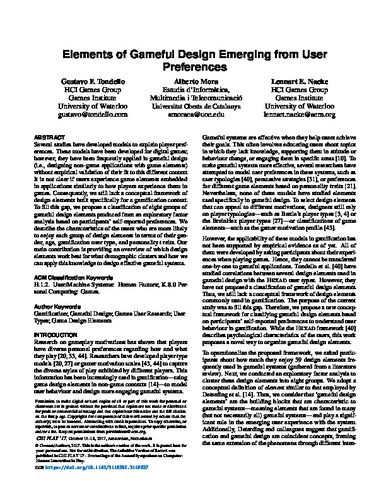| dc.contributor.author | Fortes Tondello, Gustavo | |
| dc.contributor.author | Mora, Alberto | |
| dc.contributor.author | Nacke, Lennart | |
| dc.date.accessioned | 2018-09-04 16:56:42 (GMT) | |
| dc.date.available | 2018-09-04 16:56:42 (GMT) | |
| dc.date.issued | 2017-10-15 | |
| dc.identifier.uri | http://dx.doi.org/10.1145/3116595.3116627 | |
| dc.identifier.uri | http://hdl.handle.net/10012/13714 | |
| dc.description | © Owners/Authors, 2017. This is the author's version of the work. It is posted here for your personal use. Not for redistribution. The definitive Version of Record was published in CHI PLAY '17 - Proceedings of the Annual Symposium on Computer-Human Interaction in Play. | en |
| dc.description.abstract | Several studies have developed models to explain player preferences. These models have been developed for digital games; however, they have been frequently applied in gameful design (i.e., designing non-game applications with game elements) without empirical validation of their fit to this different context. It is not clear if users experience game elements embedded in applications similarly to how players experience them in games. Consequently, we still lack a conceptual framework of design elements built specifically for a gamification context. To fill this gap, we propose a classification of eight groups of gameful design elements produced from an exploratory factor analysis based on participants’ self-reported preferences. We describe the characteristics of the users who are more likely to enjoy each group of design elements in terms of their gender, age, gamification user type, and personality traits. Our main contribution is providing an overview of which design elements work best for what demographic clusters and how we can apply this knowledge to design effective gameful systems. | en |
| dc.description.sponsorship | SSHRC || 895-2011-1014, IMMERSe
NSERC || RGPIN-418622-2012
CFI || 35819
Mitacs || IT07255
CNPq, Brazil
Agència de Gestió d’Ajuts Universitaris i de Recerca (Generalitat de Catalunya) || Industrial Doctorate programme 2014-DI-006 | en |
| dc.language.iso | en | en |
| dc.publisher | Association for Computing Machinery | en |
| dc.relation.ispartofseries | CHI PLAY 2017; | |
| dc.subject | Gamification | en |
| dc.subject | Gameful Design | en |
| dc.subject | Games User Research | en |
| dc.subject | User Types | en |
| dc.subject | Game Design Elements | en |
| dc.title | Elements of Gameful Design Emerging from User Preferences | en |
| dc.type | Conference Paper | en |
| dcterms.bibliographicCitation | Gustavo F. Tondello, Alberto Mora, and Lennart E. Nacke. 2017. Elements of Gameful Design Emerging from User Preferences. In Proceedings of the Annual Symposium on Computer-Human Interaction in Play (CHI PLAY '17). ACM, New York, NY, USA, 129-142. DOI: https://doi.org/10.1145/3116595.3116627 | en |
| uws.contributor.affiliation1 | Faculty of Arts | en |
| uws.contributor.affiliation1 | Faculty of Mathematics | en |
| uws.contributor.affiliation2 | David R. Cheriton School of Computer Science | en |
| uws.contributor.affiliation2 | Drama and Speech Communication | en |
| uws.contributor.affiliation2 | Games Institute | en |
| uws.typeOfResource | Text | en |
| uws.peerReviewStatus | Reviewed | en |
| uws.scholarLevel | Faculty | en |
| uws.scholarLevel | Graduate | en |

